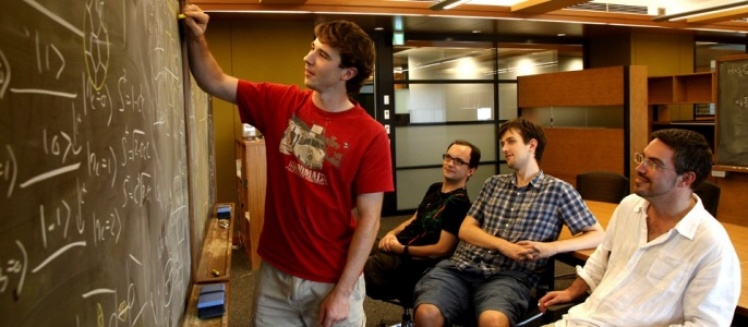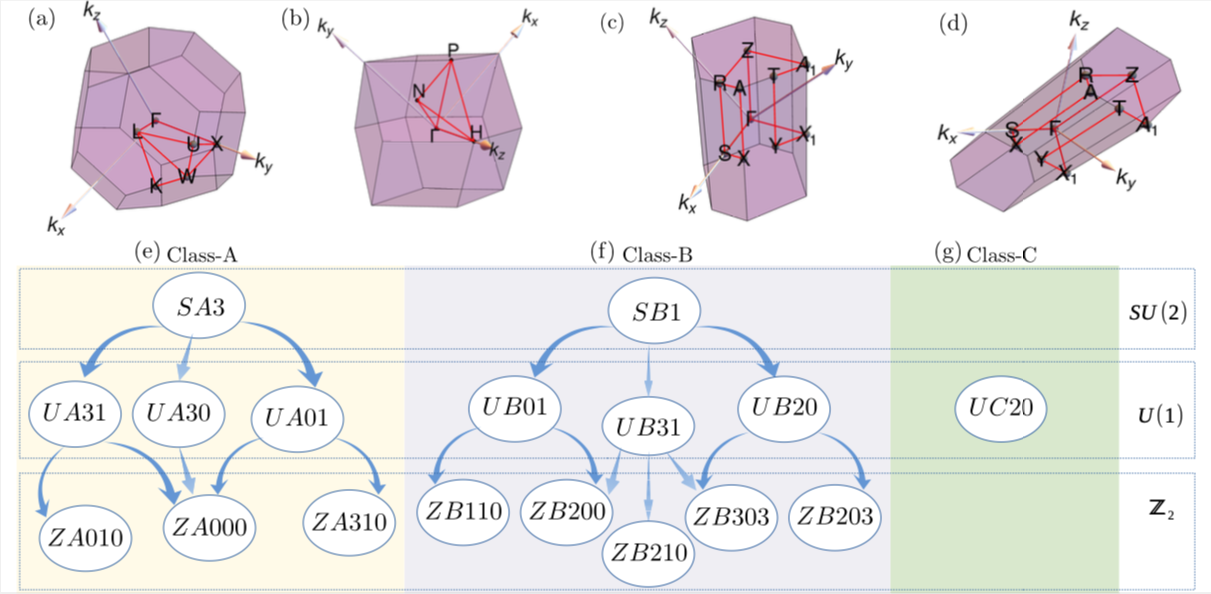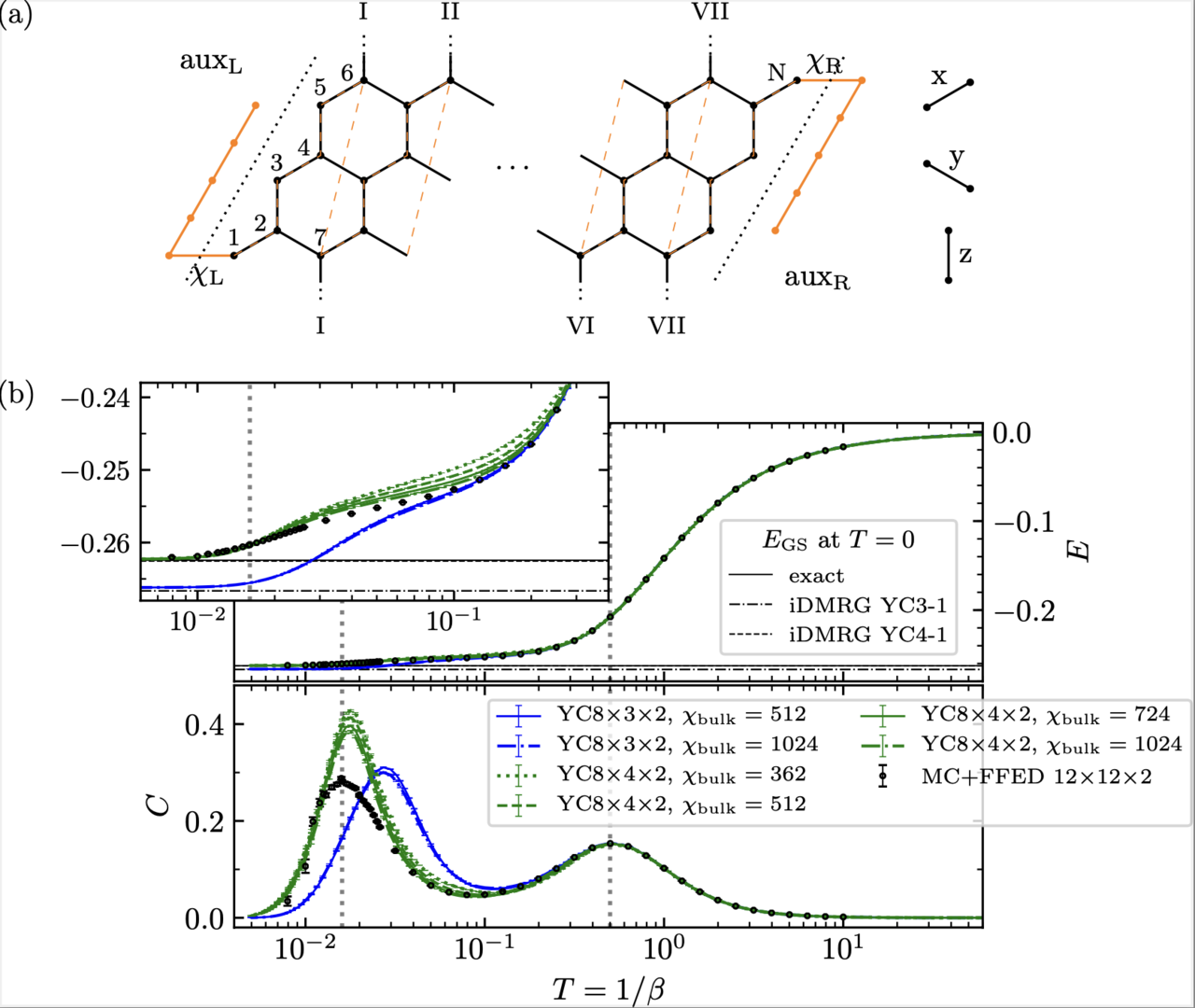FY 2023 Research & Annual Reports

The Theory of Quantum Matter (TQM) Unit carries out research into a wide range of problems in condensed matter and statistical physics, with an emphasis on the novel phases of matter found in frustrated magnets. Other topics of current interest include the application of machine learning to problems in physics, and algorithmic aspects of quantum computing.
This work is described in the Annual Reports listed in the menu on the left side of this page. These provide details of all of the research carried out by the TQM Unit, publications and presentations by Unit members, outreach activity, and seminars given by visitors to TQM in OIST. Reports are organised by the Japanese financial year, with FY2022 running from April 1st 2022 until March 31st 2023.
Recent research results, and preprints, are described below.
Quantum spin liquids on the diamond lattice
Quantum spin liquids were traditionally described by the absence of a dipolar spin moment which in conventional magnets yields an order parameter. This lack of a suitable order parameter leads to the problem that Landau's theory of phase transition cannot be employed to classify these exotic phases of matter. Rather than using the absence of something as the defining property in modern condensed matter physics quantum spin liquids are thought of as phase of matter which exhibit emergent gauge fields and fractionalized quasi particles called spinons as their low-lying excitations. Extending the conventional symmetry group by these emergent gauge fields leads to the concept of projective symmetry groups or in short PSG. By using these PSG, we are in a position to extent Landau's framework and apply it to classify these unconventional quantum states. A lot of effort has been put into the study of quantum spin liquids in two dimensions. Yet very often one has to rely on mean-field approximations which not always turn out to be the correct assumption, especially in low dimensions. This is problem is concomitant to the emergence of continuous compact gauge fields which give rise to low lying gapless excitations. It then becomes crucial for the stability of a quantum spin liquid candidate to break the initial SU(2) gauge group to smaller subgroups. This breaking of the local symmetry is very similar to what is happening in a superconductor. However, the symmetry breaking is not caused by glueing two electrically charged electrons into a Cooper pair but by pairing of chargeless spinons.
In this work we study the diamond lattice; a three-dimensional frustrated lattice which may be the perfect setting for quantum spin liquid physics. We apply the PSG framework to classify and construct possible spin liquid candidates. We give a detailed description of how the emergent gauge group for different classes descents from SU(2) via U(1) down to Z2. After a self-consistency treatment, we employ variational Monte Carlo techniques to Gutzwiller project some of the most competitive states to discuss their characteristics in depth.

Illustration of (a) first Brillouin zone for class-A Ansätze, (b) the corresponding extended Brillouin zone. Illustration of the reduced Brillouin zones required for class-B (c) and class-C (d) Ansätze involving doubling and quadrupling of unit cells, respectively. The high-symmetry points marked have the following coordinates: (a), Γ = (0, 0, 0), X = (0, 2π, 0), U = (π/2, 2π, π/2), W = (π, 2π, 0), K = (3π/2, 3π/2, 0), and L = (π, π, π); (b), Γ = (0, 0, 0), H = (0, 0, 4π), N = (0, 2π, 2π) and P = (2π, 2π, 2π). In (c), the coordinates are Γ = (0, 0, 0), X = (π, π/4, −π/4), Z = (0, π, π), Y = (π/2, π/2, −π/2), S = (π, 0, 0), A1 = (0, 7π/4, π/4), T = (π/2, 3π/2, π/2), A = (π, 5π/4, 3π/4), R = (π, π, π), and X1 = (0, 3π/4, −3π/4).
In (d), Γ = (0, 0, 0), X = (π/2, π/8, −π/8), Z = (0, π, π), Y = (π/4, π/4, −π/4), S = (π/2, 0, 0), A1 = (0, 11π/8, 5π/8), T = (π/4, 5π/4, 3π/4), A = (π/2, 9π/8, 7π/8), R = (π/2, π, π), and X1 = (0, 3π/8, −3π/8). The family tree of spin liquids showing the interconnection between the parent and descendent states with different gauge groups for (e) class A, (f) class B, and (g) class C.
This work was published as "Quantum spin liquids on the diamond lattice", Aishwarya Chauhan, Atanu Maity, Chunxiao Liu, Jonas Sonnenschein, Francesco Ferrarri, and Yasir Iqbal, Phys. Rev. B 108, 134424 (2023).
Gravitational wave analogues in spin nematics and cold atoms

Thermal pure matrix product state in two dimensions: tracking thermal equilibrium from paramagnet down to the Kitaev honeycomb spin liquid state
Finite temperature properties of quantum many body systems with strongly competing interactions in two spatial dimension are generically difficult to study. Characterizing a thermal quantum state is an on-going fundamental challenge since it is often a matter of quantum and classical correlations. The different representations of a thermal quantum state can categorized by their purity, in particular there exist two limits: the Gibbs state is represents a mixture over exponentially many states and is of low purity, while the thermal pure quantum (TPQ) state represents a thermal state within one pure wave function. Previously, the Gibbs state with smallest entanglement has been shown to conform to the thermal area law suitable for tensor network representation. Contrarily, the TPQ state with its volume law entanglement is difficult to study by area-law structured matrix product state (MPS). However, our specific ansatz called TPQ-MPS making use of the small entanglement bath can host a stable entanglement structure over the entire system. The figure shows the TPQ-MPS ansatz for the honeycomb lattice.

Figure: (a) Illustration of the TPQ-MPS structure for the honeycomb lattice. Black circles and lines resemble the physical sites and the lattice, while the auxiliary sites acting as an entanglement bath are highlighted in orange. (b) Numerical results for the Kitaev honeycomb model including a comparison to a reference method (MC+FFED).
In this work, we illustrate that the MPS framework provides a pure quantum many-body state representation for the thermal equilibrium in two spatial dimensions throughout the whole temperature range. Our test case is the famous Kitaev honeycomb model with characteristic features at finite temperature: two crossover signaled by broad specific heat peaks originating from the fractionalization of the spin-1/2 degrees of freedom into Z2 fluxes and itinerant Majorana fermions at high temperature and the approach of the flux-free state at low temperature. Starting from the random high temperature state, the system reaches the highly entangled fractionalized spin liquid ground state. The truncation process of TPQ-MPS efficiently discards the basis of the high temperature part and attains the highly entangled description of the topologically ordered ground state.
This work was published as "Thermal pure matrix product state in two dimensions: tracking thermal equilibrium from paramagnet down to the Kitaev honeycomb spin liquid state", Matthias Gohlke, Atsushi Iwaki, Chisa Hotta, SciPost Phys. 15, 206 (2023).
Curie-law crossover in spin liquids
The Curie-Weiss law is widely used to estimate the strength of frustration in spin liquid materials. However, the Curie-Weiss law was originally derived as an estimate of magnetic correlations close to a mean-field phase transition, which – by definition – is absent in spin liquids. Consequently, certain materials were reported to exhibit deviations from the Curie-Weiss law, making a conclusive determination of their Curie-Weiss temperature challenging, especially when the high-temperature regime becomes inaccessible in experiments.
In this work, we show that the concept of a ”Curie-law crossover” (see Fig.1) provides an accurate description of the thermodynamic properties in spin liquids. We study the generic aspect of the Curie-law crossover by comparing a variety of frustrated spin models in two and three dimensions, using both classical Monte Carlo simulations and analytical Husimi tree calculations. While the Husimi tree approximation is quantitatively accurate for all temperatures, we find that the crossover is influenced by the structure of the frustrated unit cell, rather than its lattice dimension. As a complement to traditional methods, we propose an "easy-to-use" fitting Ansatz of the reduced susceptibility, χT, which can be used to estimate the Curie-Weiss temperature, even when the high-temperature regime is not accessible in experiment. Applications to spin liquid candidate materials such as the S=1 pyrochlore magnet NaCaNi2F7, the square-kagome material KCu6AlBiO4(SO4)5Cl, and the spiral-spin liquid FeCl3 are discussed.


This work was published as "Curie-law crossover in spin liquids", Rico Pohle and Ludovic D. C. Jaubert, Phys. Rev. B 108, 024411 (2023).
Spin nematics meet spin liquids: Exotic quantum phases in the spin-1 bilinear-biquadratic model with Kitaev interactions
New discoveries are often made on the border between different disciplines. One major discipline in solid state physics is dedicated to quantum spin liquids, an unconventional state of matter accompanied by emergent gauge fields, topological order, and fractionalized excitations. Another concept is that of spin nematics, a magnetically ordered state dominated by quadrupole moments, which breaks spin-rotation symmetry by selecting an axis, while not choosing a particular direction. Usually seen as two separate areas of study, we are interested in combining those two disciplines, by asking the question: “What happens, when a spin nematic and a spin liquid meet?”
To answer this question, we showed that the S=1 Kitaev model under the influence of bilinear-biquadratic interactions hosts many unconventional ordered and disordered phases. We obtain a comprehensive phase diagram including chiral ordered and quadrupolar ordered phases, in addition to already known ferro, antiferro, zigzag and stripy phases. Intriguingly, we find that the competition between Kitaev and positive biquadratic interactions also promotes a noncoplanar finite-temperature spin liquid state, with macroscopic degeneracy and finite scalar chirality.
Our results show that the competition between spin liquid and spin nematic phases is a promising way to explore new magnetic states of matter.

Figure: Ground state phase diagram of the S=1 Kitaev model under the influence of bilinear-biquadratic interactions hosts many ordered and disordered phases, such as ferromagnetic (FM), antiferromagnetic (AFM), zigzag, and stripy orders, and spin-nematic ferroquadrupolar (FQ) order. The competition between chiral magnetic order, the Kitaev spin liquid (SL), and quadrupolar semi-order (SO) gives rise to unconventional phases, such as the twisted conical (TC), quasi-one-dimensional (q1D) coplanar, and noncoplanar (NC) ordered phases.
This work was published as "Spin nematics meet spin liquids: Exotic quantum phases in the spin-1 bilinear-biquadratic model with Kitaev interactions", R. Pohle, N. Shannon, Y. Motome, Phys. Rev. B 107, L140403 (2023).
Identifying topologically critical band from pinch-point singularities in spectroscopy
In the evolving landscape of condensed matter physics, the study of topological materials—substances whose properties are protected by their topological characteristics—has become a frontier area of research. These materials exhibit unique and robust features that promise revolutionary applications in technology and quantum computing. One of the most intriguing aspects of topological materials is the presence of gapless points in their electronic, magnonic (related to magnetic excitations), and photonic band structures. Traditionally, identifying whether these gapless points are of topological nature requires extensive analysis of the system's microscopic details, such as lattice symmetries and Hamiltonian construction, which can be a formidable challenge. However, recent advancements suggest a simpler, more universal approach to uncovering the topological secrets of materials through spectroscopy.
In this paper, we introduce a novel and simpler method for identifying topological materials through the observation of pinch-point singularities in spectroscopic data. This approach does not require intricate knowledge of a system's microscopic details but instead focuses on universal patterns in the spectroscopic intensity distribution. These patterns, indicative of the system's topological nature, encode Berry curvature—a key metric of topological characteristics. Our method significantly eases the identification of topological phases across a variety of materials, from electronic to photonic systems, making it a groundbreaking tool for researchers seeking to explore and utilize the unique properties of topological materials.

This work is described in the priprint "Identifying topologically critical band from pinch-point singularities in spectroscopy", Han Yan, arXiv:2304.02204.
Pinch points and half moons encode Berry curvature
In recent years, the discovery that the behavior of electron bands can be described using topological concepts has revolutionized condensed matter physics, offering fresh insights and prompting new lines of research. Such topological bands, first identified in materials known as "Chern Insulators" and subsequently in a variety of systems including graphene, have been pivotal in our understanding of topological insulators, semimetals, and superconductors. Extending beyond electrons, this framework has also found relevance in the study of magnetic insulators, where the excitation of magnon bands—waves of spin disturbances in magnets—carries topological indices, similar to their electronic counterparts. This advancement not only underscores the universality of topological phenomena across different material systems but also enriches our comprehension of magnetic materials and their exotic excitations.
Building on this foundational work, our research delves into the topological characteristics of magnon bands in frustrated magnets, as revealed through inelastic neutron scattering experiments. We focus on the intriguing appearance of "half moons," or crescent patterns, and "pinch points" in the scattering data, which we link to the underlying topological nature of magnon bands. Our analysis shows that these patterns signal the presence of Berry curvature, a fundamental property indicating the twist in the phase space of magnons, which plays a crucial role in their topological behavior. By studying how interactions among magnon bands lead to the opening of gaps and the subsequent emergence of finite Berry curvature, our work not only provides a novel way to identify and analyze topological excitations in magnetic materials but also bridges the gap between theoretical predictions and experimental observations. Through this, we offer a compelling glimpse into the topological landscape of magnetic excitations, potentially paving the way for new technological applications based on the unique properties of topologically non-trivial magnon bands.

This work is described in the priprint "Pinch points and half moons encode Berry curvature", Han Yan, Andreas Thomasen, Judit Romhányi, Nic Shannon, arXiv:2304.02203.



